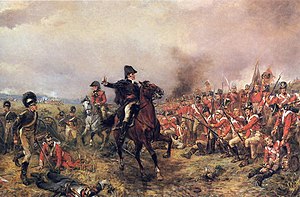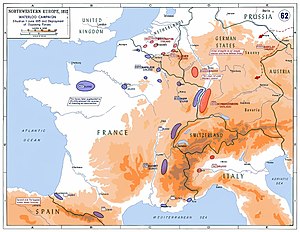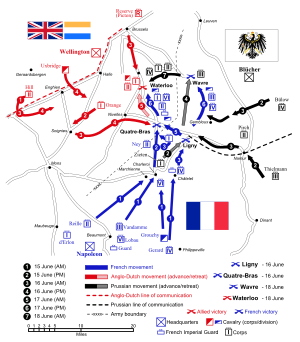ผลต่างระหว่างรุ่นของ "ยุทธการที่วอเตอร์ลู"
ไม่มีความย่อการแก้ไข |
ไม่มีความย่อการแก้ไข |
||
| บรรทัด 28: | บรรทัด 28: | ||
{{Main|Waterloo Campaign}} |
{{Main|Waterloo Campaign}} |
||
[[File:Strategic Situation of Western Europe 1815.jpg|thumb|300px|สถานการที่ยุโรปตะวันตกปี 1815 : ทหารฝรั่งเศส 250,000 นาย ต่อสู้กับพันธมิตรต่อต้านนโปเลียน 850,000 นาย โดยนโปเลียนยังต้องแบ่งกำลัง 20,000 นายไว้ที่ฝรั่งเศสตะวันตกเพื่อป้องกันกลุ่มรอยัลลิสต์ ]] |
[[File:Strategic Situation of Western Europe 1815.jpg|thumb|300px|สถานการที่ยุโรปตะวันตกปี 1815 : ทหารฝรั่งเศส 250,000 นาย ต่อสู้กับพันธมิตรต่อต้านนโปเลียน 850,000 นาย โดยนโปเลียนยังต้องแบ่งกำลัง 20,000 นายไว้ที่ฝรั่งเศสตะวันตกเพื่อป้องกันกลุ่มรอยัลลิสต์ ]] |
||
วันที่ 13 มีนาคม 1815, 6 วันก่อนนโปเลียนเดินทางถึงปารีส, [[สภาคอนเกรสแห่งเวียนนา]] |
วันที่ 13 มีนาคม 1815, 6 วันก่อนนโปเลียนเดินทางถึงปารีส, [[สภาคอนเกรสแห่งเวียนนา]][[s:Declaration at the Congress of Vienna|ประกาศให้นโปเลียนเป็นคนนอกกฏหมาย]].<ref>[http://dl.lib.brown.edu/napoleon/time7.html Timeline: The Congress of Vienna, the Hundred Days, and Napoleon's Exile on St Helena], Center of Digital Initiatives, [[Brown University]] Library</ref> สี่วันต่อมา [[สหราชอาณาจักรและไอร์แลนด์|สหราชอาณาจักร]], [[อาณาจักรรัสเซีย|รัสเซีย]], [[อาณาจักรออสเตีย|ออสเตรีย]], และ [[ปรัสเซีย]] ได้ยกกองทัพมาเพื่อกำจัดอำนาจของนโปเลียน<ref>{{Harvnb|Hamilton-Williams|1993|p=59}}</ref> นโปเลียนทราบว่า ถ้าเขาไม่สามารถป้องกันการโจมตีของมพันธมิตรต่อต้านนโปเลียนในการโจมตีฝรั่งเศสได้แล้ว เขาต้องโจมตีกองทัพของพันธมิตรก่อนที่จะยกทัพมา เพื่อรักษาอำนาจที่ตนมี ถ้าหากเขาสามารถโจมตีกองกำลังผสมที่อยู่ทางตอนใต้ของกรุงบรัสเซล ได้สำเร็จแล้ว อาจจะทำให้กองทัพอังกฤษถอยทัพออกไปยังเกาะบริเตน และทำให้กองทัพปรัสเซียพ่ายแพ้ |
||
เหตุผลอีกประการหนึ่งคือในเขตนั้นมีกลุ่มผู้สนับสนุนที่ใช้ภาษาฝรั่งเศสอยู่ (Francophone) ชัยชนะอาจทำให้เกิดการเข้าร่วมกับกองทัพฝรั่งเศส อีกประการหนึ่ง กองทัพอังกฤษที่นั่นเป็นทหารใหม่ กองทัพจำนวนมากที่เคยรบ[[สงครามคาบสมุทรสเปน]]ได้ถูกส่งไปประจำการที่อเมริกาใน[[สงครามปี 1812]]<ref>{{Harvnb|Chandler|1966|pp=1016, 1017, 1093}}</ref> |
|||
[[Image:Waterloo Campaign map-alt3.svg|thumb|300px|left|แผนที่แสดงยุทธการที่วอเตอร์ลู]] |
[[Image:Waterloo Campaign map-alt3.svg|thumb|300px|left|แผนที่แสดงยุทธการที่วอเตอร์ลู]] |
||
[[File:Napoleon crop.jpg|thumb|The resurgent [[Napoleon|Napoleon's]] strategy was to isolate the Allied and Prussian armies, and annihilate each one separately]] |
[[File:Napoleon crop.jpg|thumb|The resurgent [[Napoleon|Napoleon's]] strategy was to isolate the Allied and Prussian armies, and annihilate each one separately]] |
||
[[File:NapoleonsHeadquartersAtWaterloo.jpg|thumb|ศูนย์บัญชาการของนโปเลียน, ฟาร์มกายลู (" |
[[File:NapoleonsHeadquartersAtWaterloo.jpg|thumb|ศูนย์บัญชาการของนโปเลียน, ฟาร์มกายลู ("Caillou")]] |
||
Wellington's initial dispositions were intended to counter the threat of Napoleon enveloping the Coalition armies by moving through [[Mons]] to the south-west of Brussels.<ref>{{Harvnb|Siborne<!--W-->|1990|p=82}}.</ref> This would have cut Wellington's communications with his base at [[Ostend]], but would have pushed his army closer to Blücher's. Napoleon manipulated Wellington's fear of this loss of his supply chain from the channel ports with false intelligence.<ref>{{Harvnb|Hofschröer|2005|pp= 136–160}}</ref> He divided his army into a left wing commanded by [[Michel Ney|Marshal Ney]], a right wing commanded by [[Emmanuel, marquis de Grouchy|Marshal Grouchy]], and a reserve, which he commanded personally (although all three elements remained close enough to support one another). Crossing the frontier near [[Charleroi]] before dawn on 15 June, the French rapidly overran Coalition outposts, securing Napoleon's "central position" between Wellington's and Blücher's armies. |
Wellington's initial dispositions were intended to counter the threat of Napoleon enveloping the Coalition armies by moving through [[Mons]] to the south-west of Brussels.<ref>{{Harvnb|Siborne<!--W-->|1990|p=82}}.</ref> This would have cut Wellington's communications with his base at [[Ostend]], but would have pushed his army closer to Blücher's. Napoleon manipulated Wellington's fear of this loss of his supply chain from the channel ports with false intelligence.<ref>{{Harvnb|Hofschröer|2005|pp= 136–160}}</ref> He divided his army into a left wing commanded by [[Michel Ney|Marshal Ney]], a right wing commanded by [[Emmanuel, marquis de Grouchy|Marshal Grouchy]], and a reserve, which he commanded personally (although all three elements remained close enough to support one another). Crossing the frontier near [[Charleroi]] before dawn on 15 June, the French rapidly overran Coalition outposts, securing Napoleon's "central position" between Wellington's and Blücher's armies. |
||
รุ่นแก้ไขเมื่อ 20:56, 2 กันยายน 2556
| ยุทธการวอเตอร์ลู | |||||||
|---|---|---|---|---|---|---|---|
| ส่วนหนึ่งของ สงครามเจ็ดพันธมิตร | |||||||
 Wellington at Waterloo ผลงานของ โรเบิร์ต อเล็กซานเดอร์ ฮิลลิงฟอร์ด | |||||||
| |||||||
| คู่สงคราม | |||||||
|
|
สัมพันธมิตรครั้งที่ 7: | ||||||
| ผู้บังคับบัญชาและผู้นำ | |||||||
|
|
| ||||||
| กำลัง | |||||||
| 72,000[1] |
อังกฤษ-พันธมิตร: 68,000[1] ปรัสเซีย: 50,000[2] | ||||||
| ความสูญเสีย | |||||||
|
ตาย/บาดเจ็บ 25,000 คน ตกเป็นเชลย 7,000 คน สูญหาย 15,000[3] | ตาย/บาดเจ็บ 22,000 คน[4] | ||||||
ยุทธการที่วอเตอร์ลู เกิดขึ้นในวันอาทิตย์ที่ 18 มิถุนายน 1815 ที่ เมืองวอเตอร์ลู ซึ่งปัจจุบันอยู่ในประเทศเบลเยี่ยม, ในขณะนั้นอยู่ภายใต้การปกครองของ สหราชอาณาจักรเนเธอร์แลนด์. กองทัพแห่งฝรั่งเศสยุคจักรพรรดิที่ 1 ของจักรพรรดินโปเลียน ได้ปราชัยแก่กองทัพพันธมิตรต่อต้านนโปเลียนที่ 7, ภายใต้การนำทัพ แองโกลของ ดยุกแห่งเวลลิงตัน รวมกับกองทัพปรัสเซีย ของเกบฮาร์ด ฟอน บลือเชอร์ซึ่งเป็นการสู้รบที่ยิ่งใหญ่ที่สุดของเคมเปญวอเตอร์ลู ผลของการสู้รบทำให้นโปเลียนสิ้นสุดอำนาจการเป็นจักรพรรดิ หยุดการขึ้นสู่อำนาจ 100 วัน และนโปเลียนถูกเนรเทศไปเกาะเซนต์เฮเลนา
การกลับสู่อำนาจของนโปเลียนในปี 1815 ทำให้รัฐต่างๆ ร่วมกันต่อต้านนโปเลียนเป็นครั้งที่ 7. กองทัพจำนวนมากของเวลเลสลีย์ และบลือเชอร์ได้ตั้งอยู่ทางตะวันออกเฉียงเหนือของฝรั่งเศส นโปเลียนวางแผนเข้าโจมตีเพื่อป้องกันไม่ให้กองทัพทั้งสอง เข้ารวมกับกองทัพของรัฐต่างๆ การตัดสินใจนี้เรียกว่าเคมเปญที่วอเตอร์ลู (16–19 มิถุนายน 1815) เวลลิงตันเคยกล่าวไว้ว่า สงครามนี้เป็น "the nearest-run thing you ever saw in your life" .[5]
นโปเลียนได้ชะลอการโจมตีถึงตอนเที่ยงวันที่ 18 เพื่อให้พื้นแห้ง ในขณะที่กองทัำพของเวลลิงตันได้ประจำตำแหน่งไปตามถนนที่เนินมงต์-แซงต์-ฌอง ตั้งรับการโจมตีของฝรั่งเศสจนถึงตอนเย็น กองทัพของบลือเชอร์ได้มาถึงและเข้าโจมตีทางขวาของกองทัพฝรั่งเศส ร่วมกับกองทัพของเวลลิงตันที่ได้เข้าโจมตีกองทัพฝรั่งเศสจนหมดสภาพในการรบ กองกำลังผสมได้เข้าสู่ประเทศฝรั่งเศสและคืนอำนาจแก่หลุยส์ที่ 18 แห่งฝรั่งเศส นโปเลียนถูกถอดจากอำนาจและถูกเนรเทศไปเกาะเซนต์เฮเลนา
ปัจจุบันสมรภูมินี้อยู่ในประเทศเบลเยี่ยม ระยะทางประมาณ 8 ไมล์ (13 กิโลเมตร) จากทิศใต้ไปตะวันออกเฉียงใต้ของกรุงบรัสเซล และ 1 ไมล์ (1.6 กิโลเมตร) จากเมืองวอเตอร์ลู ปัจจุบันมีรูปปั้นไลออนส์โมนด์ตั้งอยู่
ต้นเหตุ

วันที่ 13 มีนาคม 1815, 6 วันก่อนนโปเลียนเดินทางถึงปารีส, สภาคอนเกรสแห่งเวียนนาประกาศให้นโปเลียนเป็นคนนอกกฏหมาย.[6] สี่วันต่อมา สหราชอาณาจักร, รัสเซีย, ออสเตรีย, และ ปรัสเซีย ได้ยกกองทัพมาเพื่อกำจัดอำนาจของนโปเลียน[7] นโปเลียนทราบว่า ถ้าเขาไม่สามารถป้องกันการโจมตีของมพันธมิตรต่อต้านนโปเลียนในการโจมตีฝรั่งเศสได้แล้ว เขาต้องโจมตีกองทัพของพันธมิตรก่อนที่จะยกทัพมา เพื่อรักษาอำนาจที่ตนมี ถ้าหากเขาสามารถโจมตีกองกำลังผสมที่อยู่ทางตอนใต้ของกรุงบรัสเซล ได้สำเร็จแล้ว อาจจะทำให้กองทัพอังกฤษถอยทัพออกไปยังเกาะบริเตน และทำให้กองทัพปรัสเซียพ่ายแพ้
เหตุผลอีกประการหนึ่งคือในเขตนั้นมีกลุ่มผู้สนับสนุนที่ใช้ภาษาฝรั่งเศสอยู่ (Francophone) ชัยชนะอาจทำให้เกิดการเข้าร่วมกับกองทัพฝรั่งเศส อีกประการหนึ่ง กองทัพอังกฤษที่นั่นเป็นทหารใหม่ กองทัพจำนวนมากที่เคยรบสงครามคาบสมุทรสเปนได้ถูกส่งไปประจำการที่อเมริกาในสงครามปี 1812[8]



Wellington's initial dispositions were intended to counter the threat of Napoleon enveloping the Coalition armies by moving through Mons to the south-west of Brussels.[9] This would have cut Wellington's communications with his base at Ostend, but would have pushed his army closer to Blücher's. Napoleon manipulated Wellington's fear of this loss of his supply chain from the channel ports with false intelligence.[10] He divided his army into a left wing commanded by Marshal Ney, a right wing commanded by Marshal Grouchy, and a reserve, which he commanded personally (although all three elements remained close enough to support one another). Crossing the frontier near Charleroi before dawn on 15 June, the French rapidly overran Coalition outposts, securing Napoleon's "central position" between Wellington's and Blücher's armies.
อ้างอิง
- ↑ 1.0 1.1 Hofschröer, pp. 72–73
- ↑ Chesney, p. 4
- ↑ Barbero, p. 420
- ↑ Barbero, p. 419
กองทัพของเวลลิงตัน: ตาย 3,500 คน; บาดเจ็บ 10,200 คน; สูญหาย 3,300 คน
Blücher's army: ตาย 1,200 คน; บาดเจ็บ 4,400 คน; สูญหาย 1,400 คน - ↑ Wikiquote:Wellington citing Creevey Papers, ch. x, p. 236
- ↑ Timeline: The Congress of Vienna, the Hundred Days, and Napoleon's Exile on St Helena, Center of Digital Initiatives, Brown University Library
- ↑ Hamilton-Williams 1993, p. 59
- ↑ Chandler 1966, pp. 1016, 1017, 1093
- ↑ Siborne 1990, p. 82.
- ↑ Hofschröer 2005, pp. 136–160
แม่แบบ:Link FA แม่แบบ:Link FA แม่แบบ:Link GA แม่แบบ:Link GA แม่แบบ:Link FA
